Golden retrievers are friendly, loyal, happy-go-lucky dogs that make wonderful family pets.
But even adorable puppies can get into mischief when you’re not watching them, so crate training can help keep your fur baby safe and out of trouble. A crate is an excellent tool that many dog owners use when potty training their canine companions.
Read this guide to learn some top tips on successfully crate training your Golden retriever puppy.
Table of Contents
Why Crate Train A Gold Retriever Puppy
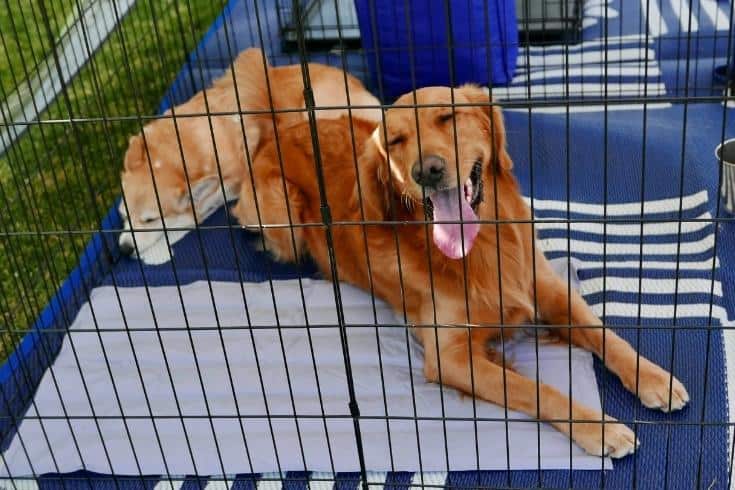
Golden retrievers are bouncy, happy-go-lucky dogs that are sure to get into mischief if allowed to roam around your home unsupervised.
So, the ideal solution is to have your Golden retriever spend some of his day confined to his crate. That way, you won’t need to worry that your furniture, shoes, and other valuables won’t get destroyed by a teething puppy. Also, crating can help to keep your puppy safe, as well as avoid potty accidents.
Also, Goldens are loyal dogs that love to be around their human family. That’s a double-edged sword, as it means your furry friend might be prone to separation anxiety if he’s left on his own for long periods. However, a cozy crate provides your pet with a secure, den-like retreat where he can relax and nap while he waits for your return.
Is It Cruel To Crate A Puppy?
Lots of new dog owners worry that confining a puppy to a crate is cruel. However, most vets and animal behaviorists disagree.
If you use positive reinforcement training methods to crate train your Golden retriever puppy and introduce the crate carefully and thoughtfully, your dog will quickly learn to love his new den. In fact, many dogs seek the restful, quiet environment of their crate when they want some peace and quiet.
However, you must never use your puppy’s crate to punish him. Shutting a puppy in a crate and scolding him will make your dog feel frightened, trapped, and frustrated. Also, keeping your puppy crated for long periods of time is not appropriate, as young puppies need frequent bathroom breaks, as well as your company.
What Are The Benefits Of Crate Training Your Golden Retriever Puppy?
So, should you crate train your Golden retriever puppy?
Well, there are many benefits to crate training your puppy, as we outline below:
A Safe, Secure Den
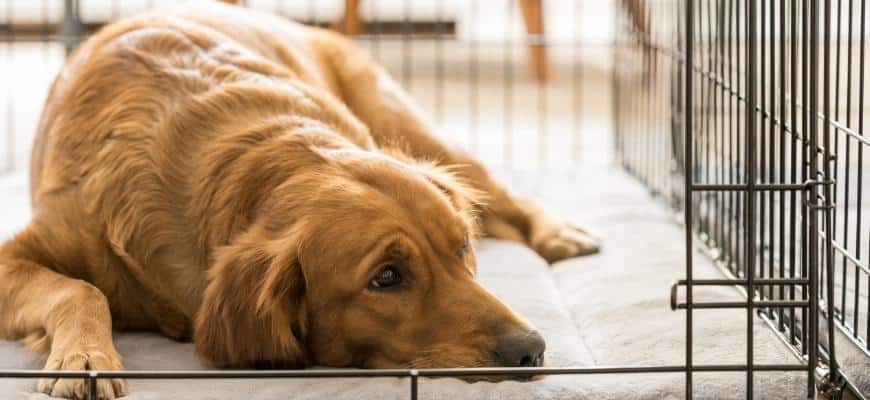
All dog breeds, including Golden retrievers, love to have a cozy den where they can enjoy some downtime whenever they want to.
A spacious, properly equipped crate that’s situated somewhere peaceful, warm, and safe provides your dog with a den-like experience that he’s bound to love.
Peaceful, Undisturbed Nights
Puppies tend to settle more quickly at night when they are contained in a cozy crate for sleep, especially if you keep the crate in your bedroom.
Potty Training
Most dog owners use a crate for potty training their puppy.
If the pup is permitted to wander around your home, potty accidents are much more likely to happen, especially if you can’t be around to keep an eye on your pet 24/7.
No dog wants to soil his sleeping area intentionally. Using a crate of the correct size can make potty training your puppy much quicker and easier.
Crates Can Help Prevent Separation Anxiety
Golden retrievers can become anxious when left home alone with the run of the house. That feeling of isolation can sometimes develop into separation anxiety.
A crate can provide a safe, secure environment where your Golden feels less stressed and anxious when you’re not around to keep him company.
Prevent Destructive Behavior
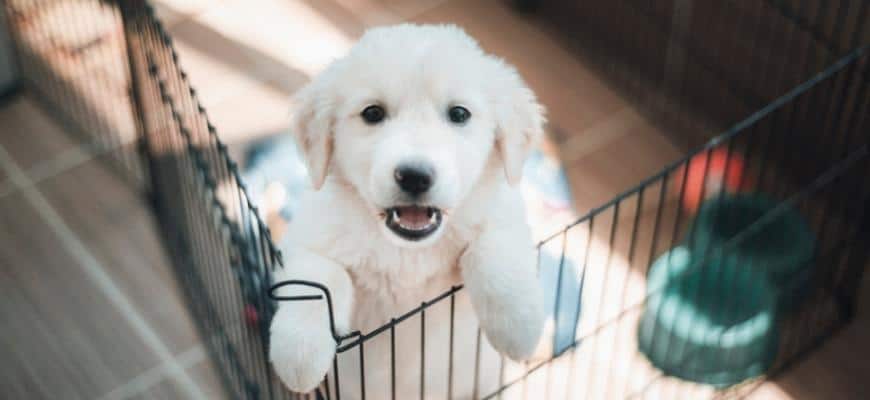
No puppy should be left alone unsupervised for long periods of time, especially when not toilet trained and when teething.
Keeping your puppy in his crate can help prevent bad habits such as chewing and destructive behavior from becoming a problem.
Keep Your Puppy Safe
Puppies can get into all kinds of trouble when you turn your back!
On a serious note, my friend’s Goldendoodle puppy once raided her bag and ate a whole packet of raisins. Raisins are highly toxic to dogs, and the poor pup ended up in the veterinary hospital for a week, and her kidneys almost failed.
A small puppy might squeeze into a tight space and get stuck or could fall down a flight of stairs. So, keeping your pup crated while you’re not around to watch him can help to keep your pet safe and sound.
Safe Travel
Crating your dog is the safest way for your dog and passengers to travel in a car or on an airplane.
Are Golden Retriever Puppies Hard To Crate Train?
Golden retrievers are intelligent, highly trainable dogs, so crate training your puppy should be relatively straightforward, and the basics can generally be achieved in just a couple of weeks.
When Should I Start Crate Training My Golden Retriever Puppy?
Crate training is much quicker and usually more successful if you begin the process from day one.
By all means, spend lots of time playing with your puppy and enjoying plenty of puppy snuggles, but get started on crate training right away.
What Type Of Crate Is Best?
You can buy several different types of crates, including:
- Wire crates
- Soft-sided crates
- Wooden crates
- Plastic crates
- Heavy-duty metal crates
All these types of crates have advantages and disadvantages. However, we recommend a high-quality wire crate for your Golden retriever puppy.
Wire crates are affordable, easy to clean, well-ventilated, and collapsible for convenient storage and portability.
What Crate Size Do I Need For A Golden Retriever?
As a general rule, your puppy’s crate should give your pet sufficient space to
- Stand upright without his head or ears hitting the crate roof
- Lie down and stretch flat out without his feet bumping the crate sides
- Sit down without his ears or head hitting the crate roof
- Turn around easily without bumping into the crate sides
Generally, a 42-inch crate is the best size crate for a Golden retriever.
A crate with a divider panel is the best choice if you have a puppy. As previously mentioned, a dog won’t soil its sleeping area unless the crate size is too big, when the pup might use one end of the crate for toileting and the other for sleeping.
A divider panel enables you to make the crate smaller when crate training puppies. Simply move the divider to make a larger crate as your puppy grows.
What Do You Need For Crate Training?
As well as a wire crate, you’ll need to invest in the following products before you start:
- Washable Crate mat or pad
- Non-slip liner
- Mother’s blanket
- Crate water bottle
- Crate cover
- Chew toys
- Food bowl
- Treats
Make sure you have all the above items before you bring your Golden retriever puppy home so that you can get started crate training him right away.
Guide To Crate Train Golden Retriever Puppies
Here’s a handy step-by-step guide on how to crate train your Golden retriever puppy.
1. Position The Crate
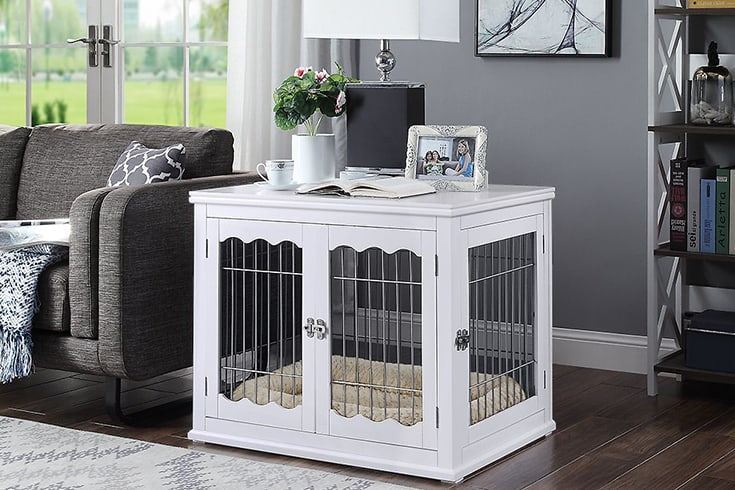
Before you set off to collect your puppy, decide where you want his crate to be. Ideally, your pup’s crate should be placed:
- Out of drafts
- Out of direct sunlight and not too close to direct heat sources
- Somewhere quiet and not in a doorway or high-traffic area
- Close to your family so that the puppy isn’t isolated
- Away from power outlets and cables
Check your home for items that could be targeted for chewing or could harm your puppy, and move those things out of reach.
2. Prepare The Crate
Fit the crate with a non-slip crate liner, comfy bed, or crate pad, and put a tempting chew toy inside.
Put a bowl of water and a packet of treats close by. Wedge the crate door open so that your puppy doesn’t startle himself if he bumps into it.
3. Introduce The Puppy To His Crate
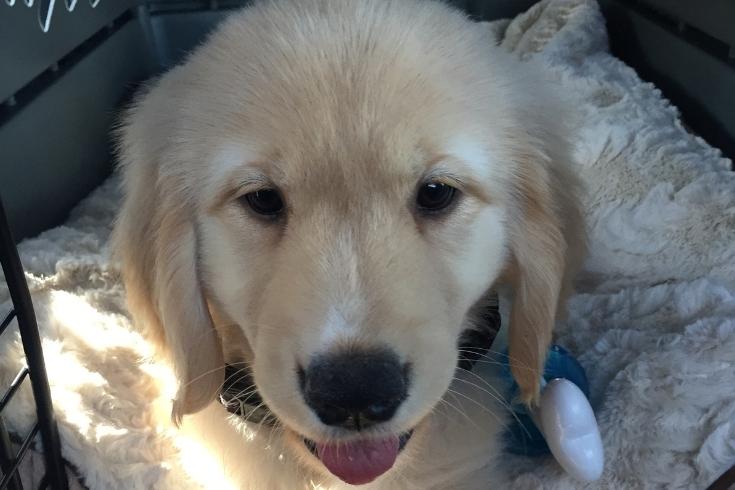
Once you’ve arrived home safely and given your puppy a chance to relieve himself outside, you can introduce him to the crate.
If possible, try to get the puppy’s mother’s blanket. The blanket will carry the mom’s scent, providing the puppy with a feeling of safety and familiarity that’s essential if he’s to settle in strange surroundings.
Cut a small piece of the blanket and put it in the crate. Keep the rest of the blanket for future use. If you use the whole blanket and the puppy has an accident on it, you’ll need to wash the blanket, and that would remove the mom’s scent.
Let the puppy check out the area around the crate. Curious pups might even voluntarily venture inside the crate!
4. Make The Crate A Positive, Happy Environment
Make the crate comfy and welcoming. Put a few tempting treats inside the crate, close to the door. Golden retrievers are notoriously food-oriented dogs that will most likely be enticed into the crate by those yummy treats.
Never force the puppy into the crate. Chat to your pet, offer him more treats, and add a fun toy to the mix to persuade your furry friend to go into the crate. Generally, placing the crate around people will help to encourage your puppy to feel comfortable spending time inside it.
5. Play Crate Games
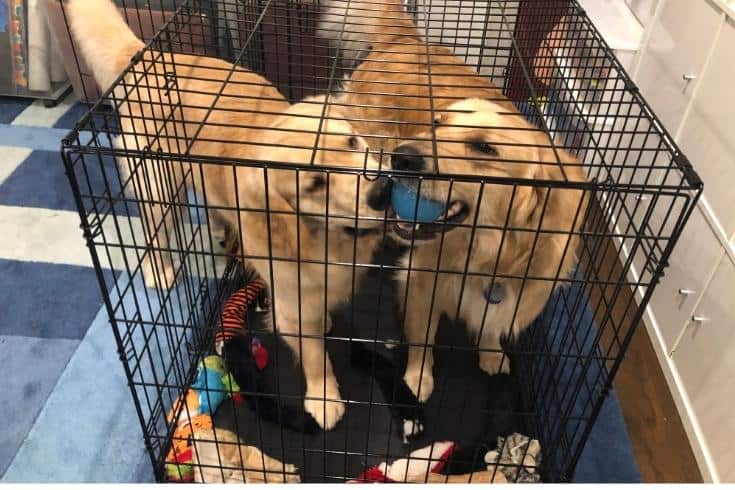
Crate sessions can be made more enjoyable for your puppy by incorporating some crate games.
Use treats, cuddly toys, or a KONG toy stuffed with frozen peanut butter or treats to reward your puppy for entering his crate.
6. Crate Feeding Your Golden Retriever Puppy
Golden retrievers are very food-oriented, and you can use that to enhance and speed up the crate training process considerably.
Allow your puppy to watch you prepare his meal, and then place the food bowl just inside the crate. Once your puppy is confidently going into the crate to get the food, move the food bowl to the back of the crate.
7. Shut The Door
By now, your Golden retriever puppy should view the crate as a safe, comfortable, fun place to be. So, try closing the crate door when your puppy is happily tucking into his food.
The first time the door is closed, open it again once your pet has finished eating. Open the door before the pup realizes he’s shut in the crate and starts complaining by barking or whining.
At each crate training session, leave the door shut for a little longer. Once you reach this point in the crate training series, your aim is to confine the puppy in the crate for roughly five minutes after he’s finished eating, ideally without complaining.
8. Step Back Away From The Crate
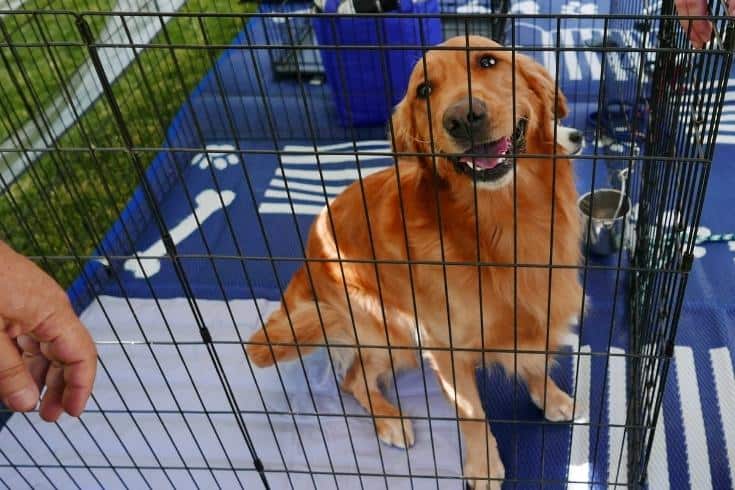
Assuming that your crate routine is going well, your Golden retriever puppy should now associate the crate with a couple of treats, toys, games, and eating his meals.
A common mistake people make is that they try to move too far away from the puppy too soon. Provided that the puppy is calm, you can now move away from the crate. Stay within your puppy’s line of sight at all times, gradually increasing the time that the door remains shut.
If your puppy starts whinging, turn your back on your pet, and wait a few minutes until the whining stops. After ten seconds of your pet remaining calm, you can turn around and allow him to come out of the crate.
Watch your puppy throughout this exercise, and let your pet out of the crate as soon as he shows signs of anxiety.
9. Increase The Time The Crate Door Is Shut
If all goes well, you can gradually begin to extend the length of time your puppy is confined until he’s able to wait for around an hour before he needs to be let out for a bathroom potty break.
Very young puppies aged up to ten weeks old will need to relieve themselves immediately after a meal. So, try increasing your puppy’s crate time by timing his meals right after a bathroom visit.
10. Potty Breaks
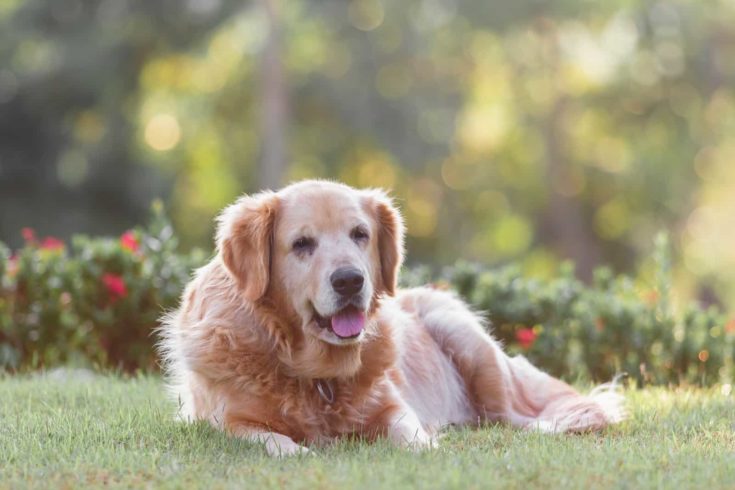
When you begin your crate training puppy schedule, observe your pet closely for tell-tale signs that he needs to go potty.
Generally, puppies will start whining, circling, and sniffing the ground when they need to relieve themselves. When that happens, immediately grab your puppy, and get him to his assigned toilet spot.
Eight-week-old puppies typically need to go for a pee around every 30 to 60 minutes. During warm weather or after exercise, when the puppy drinks more, he might need to go more often than that. Once the puppy is older, he will be able to wait for longer between potty stops.
11. What About Bedtime?
Although it’s tempting to allow your puppy to snuggle up with you in your bed to sleep at night, try to resist those pleading, brown eyes!
The safest place for your puppy to spend the night is confined in his crate. Although your pup might experience a bit of separation anxiety from bedtime crating at first, you can help to mitigate that by putting the crate in your bedroom with you. Use a crate cover to create that safe, den-like space that encourages your canine companion to settle down and sleep.
Sometimes, giving your Golden retriever puppy a special treat reserved for bedtime can help him understand that his crate is a comfortable space to spend the night.
Expect Disturbed Nights!
When your puppy is very young, you can expect to be disturbed by his cries for attention during the night. That’s not bad behavior but is just your pet’s way of letting you know that he needs to go outside for a potty break.
Dogs are clean animals, and they will resist soiling their sleeping area if at all possible. So, set your alarm to wake you up every couple of hours throughout the night so that you can take your puppy outside to relieve himself. Although that means you’ll have to accept having disturbed nights for a couple of weeks, it’s all part of bringing up a new puppy!
12. Immediately Clean Up Accidents
Unfortunately, dealing with potty accidents is all part and parcel of raising and training a new puppy. When that happens, never punish or scold your pup. You want your pet to be happy spending time in his crate, and you must never use his “den” as a punishment tool.
When accidents happen around your home, use an enzyme cleaner to remove the scent of urine from your floor coverings. Dogs have an extremely keen sense of smell, and your pet will probably regard the accident site as an approved potty spot if you don’t get rid of the odor.
If your puppy has an accident in his crate, you must wash all the bedding immediately. Ensure that you have a good supply of spare bedding to grab if you need it, and clean the crate thoroughly to remove any lingering smell of urine.
13. Use Verbal Cues
Verbal cues are an extremely important element of any aspect of your puppy’s training. Golden retrievers are especially quick at remembering simple words, and these trainable dogs are typically pretty obedient.
So, from the get-go, you need to begin using verbal cues. Pick short and clear words so that your puppy can easily recognize and remember them. Two favorite cues for crate training are “Bed” or “Crate.”
It’s perfectly normal for things to go slightly awry sometimes when crate training your puppy, so you’ll need to choose some cues for negative and positive behavior, too. “No!” and “Good dog” are popular choices that work well.
Combine your cue words with crate training. For example, when you ask your puppy to enter the crate, give him a treat and say your cue word, such as “Bed” or “Crate.” Once your pet has obediently entered the crate, shut the door gently, give him a couple of treats, and praise him by telling him what a “Good dog” he is.
14. Increase The Difficulty
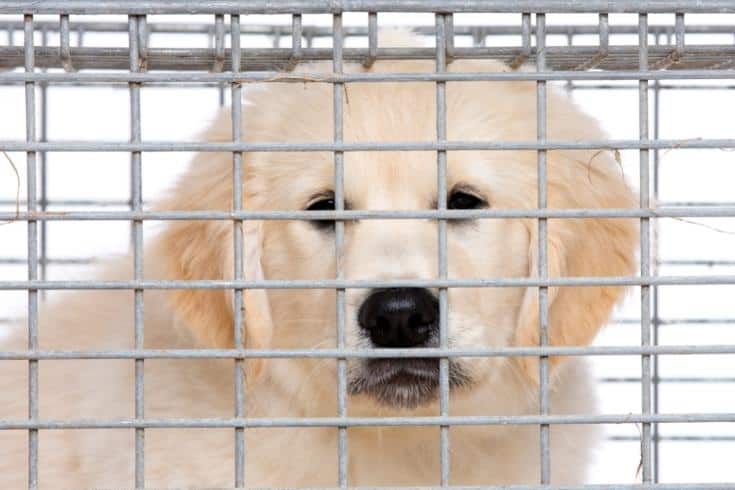
As crate training progresses, you can make things more challenging for your puppy. Ask your dog to stay in the crate with the door closed for longer periods, and begin to move out of sight.
Aim to have your puppy spend one to two hours confined in his crate after two weeks’ training. You’ll find it helpful to spend lots of time between crating sessions playing with your puppy or exercising him so that he’s ready for a nap when you send him into his crate. Your puppy must learn to be happy spending time in his crate during the daytime when you’re around as part of his usual daily routine.
15. Tantrums!
Just like little kids, puppies will throw tantrums during the first few days of crate training. Don’t panic! That behavior is perfectly normal and to be expected, especially when you first close the crate door.
However, it’s crucial that you don’t give in and let your puppy come out of the crate every time he starts barking or whining. You’re training your pet to behave badly if you let your crying puppy out every time he has a tantrum! Only allow your pet to leave the crate when he’s calm.
Instead, reward calm behavior with treats verbal praise, and let your puppy come out of the crate. So, when a tantrum kicks off, simply turn your back on your furry friend, and wait until he settles down again.
16. Consistency Is Crucial!
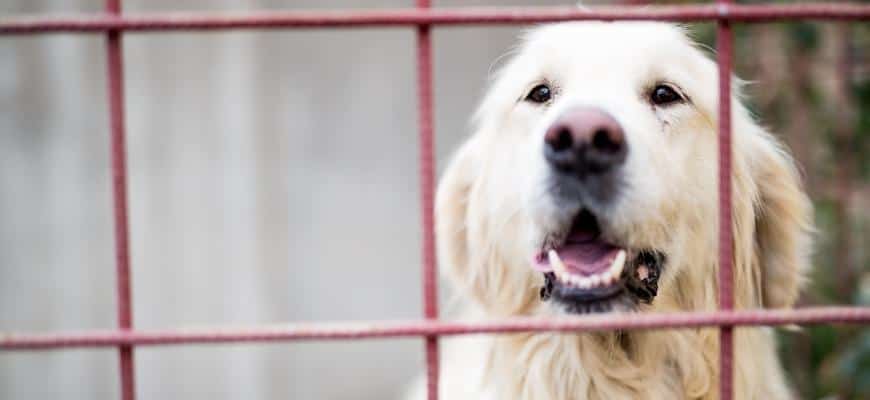
One of the most common problems people experience when crate training their puppy is not being consistent.
When you’re crate training a puppy, you don’t get to take time off! Yes, it can be tough when your adorable fluffy bundle is crying and whining inside his crate. Surely, taking him out for a snuggle and a cuddle won’t hurt? Unfortunately, giving in to your fur baby when he complains simply teaches your pet that whining and other bad behavior get him what he wants, which sets your training regimen back.
17. Playtime Is Vital
A lively Golden retriever puppy bursting with energy is not likely to settle calmly in his crate. Therefore, you can make crate training your puppy much easier for both of you by ensuring that he’s had plenty of exercise and playtime throughout the day and right before you crate your puppy at bedtime.
A tired puppy is much more likely to be happy spending time relaxing and sleeping in his comfortable, safe space than one that’s frustrated and full of pent-up energy.
Final Thoughts
I hope you enjoyed our guide to crate training a Golden retriever puppy. If you did, please remember to share it.
Your puppy’s crate is a safe space where your pet can relax in comfort whenever he wants to get a bit of peace and quiet. Crates are also useful tools for potty training your puppy and preventing bad behavior, such as chewing and eating harmful substances. Always be consistent and patient when crate training your puppy; use cue words and positive reinforcement to make learning fun for both your pet and you.
Did you use a crate to train your Golden retriever puppy? Tell us how you did in the comments box below.